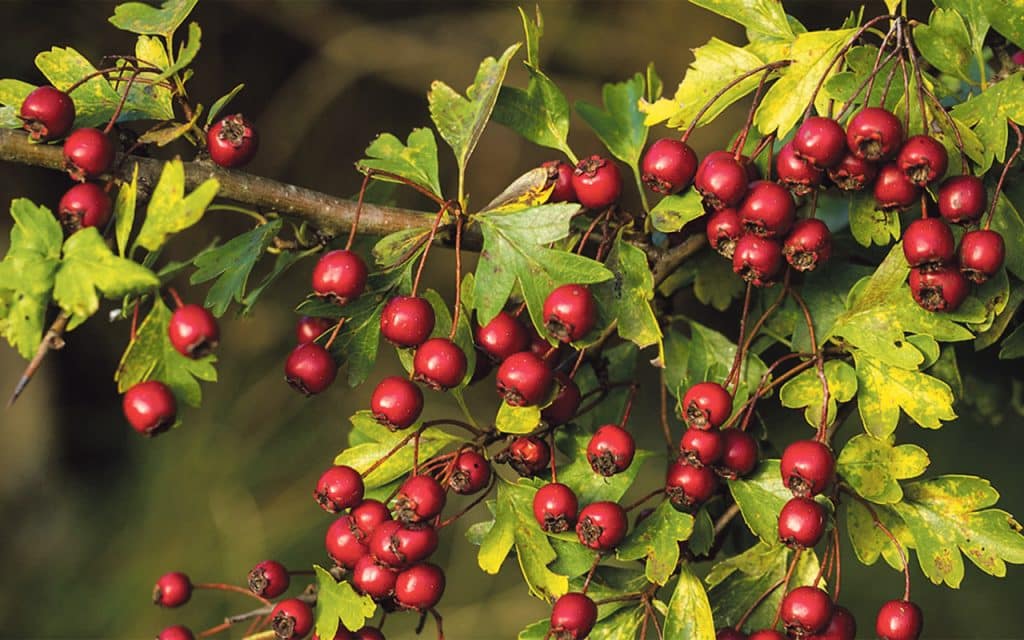
Hawthorn berry, or ‘Crataegus fructus’, is abundant this year in the hedgerows and is just ready for picking. Hawthorn has a long history of supporting heart health, so its fruit is a great addition to the herbal home pharmacy. However, it is very important to be careful when harvesting because the plant has thorns that can hold bacteria and cause problems if they pierce the skin.
Crataegus berries are full of antioxidants, flavonoids, and procyanidins. These are substances that help the heart by lowering blood pressure, reducing inflammation, and improving circulation. Clinical evaluations and scientific investigations indicate that hawthorn extract improves heart muscle contraction, regulates irregular rhythms, and facilitates recovery in cases of heart failure or post-myocardial infarction. Hawthorn also seems to decrease cholesterol, helps make nitric oxide, which widens and relaxes blood vessels, and it also protects cardiac cells from oxidative stress and damage from lack of blood flow.
Many herbalists recommend regular intake of hawthorn in teas, decoctions, or tinctures for those managing mild heart conditions, high blood pressure, or cholesterol. However, caution is advised for individuals on prescription cardiac medications and these individuals should seek a clinician’s guidance. The fruit’s gentle tonic action supports heart function and strengthens vascular tone over time.
If this year’s bumper crop leaves you with more berries than can be freshly consumed or dried, freezing is an easy way to preserve their nutrition and flavour for later use. After harvesting, wash and thoroughly dry the berries to prevent mildew. Sort to remove damaged fruits and pour them into freezer-safe bags or containers, removing as much air as possible before sealing. Once frozen, hawthorn berries will keep up to a year; thaw before use and they can then be turned into syrups, jams, or decoctions.
To make a nourishing hawthorn berry decoction, use these simple steps:
• Measure about 30g (2-3 tablespoons) of fresh or dried hawthorn berries.
• Place in a saucepan and add 500ml cold water.
• Simmer gently with a lid for 30-60 minutes, avoiding vigorous boiling to preserve vitamins and reduce bitterness.
• Strain and drink; this brew can be enjoyed warm or cool.
Allow the decoction to steep for about ten minutes after simmering, as this improves both flavour and extraction of beneficial compounds. 500ml should give two to three cups a day.
When picking the haws, always make sure the berries are sourced from unsprayed and uncontaminated locations. Also use gloves, as the thorns of this bush can cause more damage than the initial discomfort. The hawthorn has developed a number of strategies over the centuries to protect itself from livestock, who will generally not eat it. This is one of the reasons it is used so extensively for fencing and why, in times past, people were very careful to check horses after a day out horse riding where they may have jumped over hawthorn hedges. They checked the horses for puncture wounds caused by the thorns, and they had good reason to do so, as the thorns can harbour a number of nasty bacteria. These include staphylococcus aureus, which can lead to local sores, cellulitis, and even endocarditis if it gets into the bloodstream. They can also contain different types of streptococci and this bacteria cause erysipelas or cellulitis, which are red spots that spread quickly and cause fever and serious pain. In deeper and dirty cuts, one needs to be alert for another nasty called pseudomonas aeruginosa. This can cause an infection that takes a long time to heal. If one does get pricked by a thorn, keep an eye on it and get medical attention if there is increasing pain, redness or warmth around the puncture site. Needless to say, difficulty moving the affected part, and red streaks spreading out from the site also require immediate actions.
This year, hawthorn berries are plentiful, and it is a great herb for heart health and home herbal use. Freezing berries keeps their excellent qualities, and decoctions make them useful in everyday life. But it’s important to respect the thorns. Taking care of them, keeping them clean, and acting quickly if you get hurt will make sure you and your harvest stay safe.



